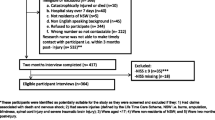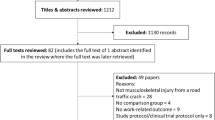Abstract
Purpose
Professional electricians are highly subjected to electrical injuries. Previous studies describing symptoms after electrical injury have not included people with less severe initial injuries. The purpose of the present study was to describe symptoms at different time points after electrical injury, the impact of “no-let-go” phenomenon and different electrical potential [high voltage (HV) vs. low voltage (LV)], and the safety culture at the workplace.
Methods
A retrospective survey was conducted with 523 Swedish electricians. Two questionnaires were issued: the first to identify electricians who had experienced electrical injury and the second to gain information about symptoms and safety culture. Self-reported symptoms were described at different time points following injury. Symptoms for HV and LV accidents were compared. Occurrence or nonoccurrence of “no-let-go” phenomenon was analysed using two-tailed Chi-2. Safety culture was assessed with a validated questionnaire.
Results
Nearly all reported having symptoms directly after the injury, mainly paraesthesia and pain. For the first weeks after injury, pain and muscle weakness dominated. The most frequently occurring symptoms at follow-up were pain, muscle weakness and loss of sensation. HV injuries and “no-let go” phenomenon were associated with more sustained symptoms. Deficiencies in the reporting routines were present, as well as shortage of preventive measures.
Conclusion
The results indicate that symptoms are reported also long time after an electrical injury and that special attention should be paid to HV injuries and “no-let go” accidents. The workplace routines to reduce the number of work-related electrical injuries for Swedish electricians can be improved.

Similar content being viewed by others
References
Arbetsmiljöförordningen (1997:1166). http://www.notisum.se/rnp/sls/lag/19771166.htm. Accessed 10 June 2015
Arbetsskador (2008) Occupational accidents and work-related diseases (2009) Arbetsmiljöstatistik Rapport 2009:1. Arbetsmiljöverket, Solna
Arnoldo BD, Purdue GF, Kowalske K, Helm PA, Burris A, Hunt JL (2004) Electrical injuries: a 20-year review. J Burn Care Rehabil 25:479–484
Bailey B, Gaudreault P, Thivierge RL (2008) Neurologic and neuropsychological symptoms during the first year after an electric shock: results of a prospective multicenter study. Am J Emerg Med 26:413–418. doi:10.1016/j.ajem.2007.06.021
Baruch Y, Holtom BC (2008) Survey response rate levels and trends in organizational research. Hum Relat 61:1139–1160. doi:10.1177/0018726708094863
Butler ED, Gant TD (1977) Electrical injuries, with special reference to the upper extremities. A review of 182 cases. Am J Surg 134:95–101
Chudasama S, Goverman J, Donaldson JH, van Aalst J, Cairns BA, Hultman CS (2010) Does voltage predict return to work and neuropsychiatric sequelae following electrical burn injury? Ann Plast Surg 64:522–525. doi:10.1097/SAP.0b013e3181c1ff31
Danielsson M, Gilliam H, Hemström Ö (2009) Tobacco habits and tobacco-related diseases. In: Health in Sweden: The National Public Health Report 2009. National Board of Health and Welfare, Stockholm
Ek A (2006) Safety culture in sea and aviation transport. Dissertation, Lund University. http://lup.lub.lu.se/luur/download?func=downloadFile&recordOId=546920&fileOId=546921. Accessed 6 October 2014
Fordyce TA, Kelsh M, Lu ET, Sahl JD, Yager JW (2007) Thermal burn and electrical injuries among electric utility workers, 1995–2004. Burns 33:209–220. doi:10.1016/j.burns.2006.06.017
Goffeng LO, Veierstad KB, Kjuus H (2006) Senfølger etter lavspent strømgjennomgang hos elektromontører: en etterundersøkelse av elektrikere utsatt for ulykker meldt Direktoratet for samfundssikkerhet og beredskap. http://www.stami.no/sporreskjema-og-sjekklister-ved-stromulykker. Accessed 7 Oct 2014
Huss A, Vermeulen R, Bowman JD, Kheifets L, Kromhout H (2013) Electric shocks at work in Europe: development of a job exposure matrix. Occup Environ Med 70:261–267. doi:10.1136/oemed-2012-100732
Hussmann J, Kucan JO, Russell RC, Bradley T, Zamboni WA (1995) Electrical injuries—morbidity, outcome and treatment rationale. Burns 21:530–535
Piotrowski A et al (2014) Outcome of occupational electrical injuries among French electric company workers: a retrospective report of 311 cases, 1996–2005. Burns 40:480–488. doi:10.1016/j.burns.2013.08.008
Singerman J, Gomez M, Fish JS (2008) Long-term sequelae of low-voltage electrical injury. J Burn Care Res 29:773–777. doi:10.1097/BCR.0b013e318184815d
Swedish Electricians’ Union (2010) A work environment study-test 2
Swedish National Electrical Safety Board (2005) Interview study on electrical accidents with electrical injury. Markör Marknad och kommunikation AB
Tkachenko TA, Kelley KM, Pliskin NH, Fink JW (1999) Electrical injury through the eyes of professional electricians. Ann N Y Acad Sci 888:42–59
Weick KE, Sutcliffe KM (2007) Managing the unexpected: resilient performance in an age of uncertainty, 2nd edn. John Wiley & Sons Inc, San Fransisco
Wenemark M (2010) The respondent’s perspective in health-related surveys: the role of motivation. Dissertation, Linköping University. http://urn.kb.se/resolve?urn=urn:nbn:se:liu:diva-60183. Accessed 3 Mar 2015
Wesner ML, Hickie J (2013) Long-term sequelae of electrical injury. Can Fam Physician 59:935–939
Acknowledgments
The present study was funded by the Swedish Research Council for Health, Working Life and Welfare (previously Swedish Council of Working life (FAS Number 2010-0561)) and by the Örebro Research Committee. We would like to express our gratitude to the Swedish Electricians Union, the Swedish Association of Electrical Contractors and the Swedish National Electrical Safety Board for contributions to knowledge in the field of electrical industry and to Lars Ole Goffeng PhD, psychologist and researcher, National Institute of Occupational Health, Norway, for his valuable contributions to the questionnaire. Thanks are also due to research assistant Ing-Liss Bryngelsson, Department of Occupational and Environmental Medicine, Örebro University Hospital for valuable help with the data analysis.
Author information
Authors and Affiliations
Corresponding author
Ethics declarations
Conflict of interest
The authors declare no conflict of interest.
Rights and permissions
About this article
Cite this article
Rådman, L., Nilsagård, Y., Jakobsson, K. et al. Electrical injury in relation to voltage, “no-let-go” phenomenon, symptoms and perceived safety culture: a survey of Swedish male electricians. Int Arch Occup Environ Health 89, 261–270 (2016). https://doi.org/10.1007/s00420-015-1069-3
Received:
Accepted:
Published:
Issue Date:
DOI: https://doi.org/10.1007/s00420-015-1069-3




